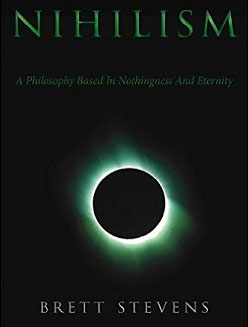Air Quality, Water Quality, and Silence Are the New Bitcoin
In the recent form of America — created by the need to make enough money to pay off the high costs created by social dysfunction in the wake of the ousting of our WASP leadership — the goal was to have a fancy house in the city, new cars, lots of gadgets, and fad cuisine.
As we dodge the rising crisis brought about by diversity-socialism, which has bankrupted Europe and the USA, we will aspire to something different entirely: clean air, clean water, lots of trees, safety, and quiet.
The new wealth is not having what everyone else wants, but having what they do not have the wisdom to see, which is that freedom from health-wrecking air pollution, mind-shattering noise, sleep-dulling light pollution, concrete jungles, insane people, and constant drama is the greatest value.
Among other things, we are starting to recognize that air pollution is making us very ill, and the wildfires are the extreme, but the everyday is just as bad:
But among the embers smoldered another, less-visible disaster: the pollution released when homes, cars, televisions, household goods and batteries burned.
“The potential toxicity of the mixture that came off these fires is probably much greater than what we saw in other major fires we’ve experienced in the US, because those fires did not affect as many urban structures,” explained Michael Jerrett, a professor of environmental science at the University of California Los Angeles.
If the exhaust, smoke, and toxic gasses do not get you, then the microplastics (MPs) will:
Worryingly, MPs were recently detected in human bone tissue. In the last years, in vitro studies have shown that MPs affect cell viability, induce cell senescence, alter adipogenic cell differentiation, modify gene expression, increase reactive oxygen species production, trigger inflammatory responses, and promote osteoclastogenesis. MPs have also been associated with the impairment of the bone marrow mesenchymal stromal cell differentiation potential. Experimental animal studies indicated that MPs ingestion disturbs gut microbiota and reduces white blood cell counts, suggesting compromised bone marrow function. MPs have been detected in bone tissue following intragastric administration and were shown to affect various blood cells. Additionally, MPs accumulation in bones reduced their growth and impaired trabecular microarchitecture likely due to the osteoblasts’ decreased osteogenic function.
Consider that your tapwater is now toxic as well:
The update highlights contaminants in U.S. drinking water, including the toxic “forever chemicals” known as PFAS, that are in the drinking water of over143 million people. Tap water throughout the U.S. can also contain volatile organic compounds, nitrate and arsenic, among many other contaminants. These pollutants, often linked to cancer, developmental issues and other health risks, are found in nearly all community water systems.
Harmful disinfection byproducts and radiological contaminants also persist in water supplies in many communities.
Hexavalent chromium, or chromium-6, is a carcinogen made infamous by the Erin Brockovich case in Hinkley, Calif., and it’s in the drinking water of over 250 million Americans. There is no federal limit for chromium-6, despite its widespread presence and link to cancer and organ damage.
If that is not depressing enough (for this site) then consider that scents may be making you unwell, multiplied by the thousands of personal care products you encounter every day on hundreds of people:
Overall, 34.7 % of the population reported health problems, such as migraine headaches and respiratory difficulties, when exposed to fragranced products. Further, 15.1 % have lost workdays or a job due to fragranced product exposure in the workplace. Also, 20.2 % would enter a business but then leave as quickly as possible if they smell air fresheners or some fragranced product. Over 50 % of the population would prefer that workplaces, health care facilities and professionals, hotels, and airplanes were fragrance-free. While prior research found that common fragranced products, even those called green and organic, emitted hazardous air pollutants, more than two thirds of the population were not aware of this, and over 60 % would not continue to use a fragranced product if they knew it emitted such pollutants.
The recent rise in cancer also seems to correlate to horrible effects of the modern lifestyle:
Last year, researchers released findings from a 150,000-person study at the annual American Association for Cancer Research meeting that took the cancer community by surprise. They found that millennials — born between 1981 and 1996 — appear to be aging biologically faster than previous generations, based on biomarkers in blood that indicate the health of various organs. That acceleration was associated with a significantly increased risk — up to 42 percent — for certain cancers, especially those of the lung, gastrointestinal tract and uterus.
Murphy determined that children whose mothers had taken bendectin, an anti-nausea drug, during pregnancy were 3.6 times more likely to develop colon cancer as adults, when all other factors were taken into consideration. Even more startling was that children of women who received a different medication to prevent miscarriage, hydroxyprogesterone caproate, had more than double the overall lifetime cancer risk. In this group, about 65 percent of cancers occurred before the age of 50.
A 2023 study published in the BMJ found that heavy consumption of ultra-processed foods was associated with significantly elevated risks of developing several cancers, including colorectal and breast cancer — two of the fastest-rising malignancies in people under 50.
In animal models, microplastic exposure has been linked to colon and lung cancer and immune system dysregulation. An analysis of peer-reviewed studies published in December 2024 and led by University of Sydney researcher Nicholas Chartres, scientific lead of the Center to End Corporate Harm, at the University of California at San Francisco, found repeated evidence linking microplastic exposure to mechanisms indicative of cancer across multiple systems — digestive and respiratory.
The city lifestyle is also crushing us. Commuting destroys sleep and light pollution destroys the home:
Data analysis revealed that even after adjusting for covariates, longer commutes predicted insomnia and daytime sleepiness, while smaller housing size predicted insomnia. Further, a trade-off was observed between commuting time and floor area in cases of insomnia. For housing units meeting the urban-oriented residential area standard of 95 m² for a four-person household, commuting times exceeding 52 minutes reached the insomnia cutoff value.
Not surprisingly, those who can afford it also want freedom from noise pollution that makes them exhausted and muddled:
I soon realized that silence was more than the absence of noise; it was an aesthetic to be revered. Yet it was an aesthetic at odds with who I was. Who a lot of us were.
Within a few weeks, the comfort that I and many of my fellow minority students had felt during those early cacophonous days had been eroded, one chastisement at a time. The passive-aggressive signals to wind our gatherings down were replaced by point-blank requests to make less noise, have less fun, do our living somewhere else, even though these rooms belonged to us, too. A boisterous conversation would lead to a classmate knocking on the door with a “Please quiet down.” A laugh that went a bit too loud or long in a computer cluster would be met with an admonishment.
In the recent old days, people wanted those big houses with lots of possessions. Now they want intangible possessions, like having clean water, mentally comfortable surroundings, unpolluted air, and silence instead of the constant gibbering and screeling of humanity. That is the new wealth.










